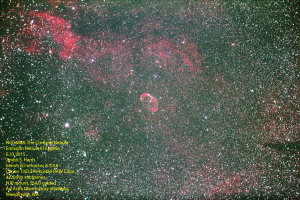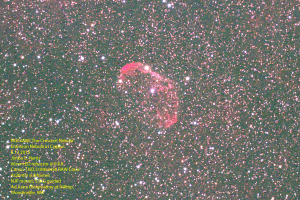I would like to announce that, somehow, out of the blue (so to speak), my astrophotography mojo has returned.
Let me ‘splain.
When shooting dim astronomical objects, the more photons you collect, the better. In practice, you can gather more photons in one of two ways: you can use a larger telescope, or you can use longer exposures. Trixie will hopefully take care of the first criterion (although there are some objects that are large enough that you want a shorter scope, at times). It is the second criterion that I’m talking about here.
In the old observatory, I used to run 20-minute subframes of each object, if I could, and then stack between three and five hours of them to produce a given image. Because the sky was so awful in Newark, I could only use such long subframes if I was using a very narrow filter, or I was at a dark sky site. Anything over 5 minutes would start to wash out the object behind all the ambient skyglow.
I had been looking forward to the same sort of behavior here at Hilltop Observatory, lots of short subframes unless I had an Ha (Hydrogen-alpha) filter onboard.
What happened, however, is that there was some horrifying trailing happening somewhere in the imaging rig. It was causing me to be unable to shoot anything longer than 5 minutes, and I couldn’t even use the auto guider, because it wasn’t working either. I resolved to find the problem, so I spent an evening gathering data, and then did a couple of little tweaks, making sure the autoguider was lined up with the mount axes, and moving the mounting rings on Pumpkin a little.
I decided to try the newly tuned rig on The Crescent Nebula, a funny little wavefront of bright hydrogen in Cygnus the Swan. The band of The Milky Way runs right through Cygnus, so the whole area is awash in nebulosity. There are little bright knots all over the place, where the relatively inert gas gets excited by some event or another, and starts glowing. The Crescent has always struck me as the result of some kind of “sloshing”, rather than a supernova, or stellar wind. I have no evidence to back this up, but there you go.
In any case, I fired up the guider, got the mount calibrated, and started a run of 5-minute exposures, hoping that the rig would behave a little. When the first couple of subframes came in, I was astonished to see round stars! Oh, there is still a little drift, you can’t see it in a single subframe, but I could watch the stars shift slightly between frames. This is standard behavior out of Rig, indicative that there is still some small pointing error between the mount and the scope. I will continue to chase that down, but there is a world of difference between “cannot guide” and “can guide”, and that fertile boundary is where I play.
When the 5m subs finished, I ran a couple of 10m, just to make sure that the guiding would hold up, and when it did, I started a run of 20m subframes and started catnapping. I got up a couple of times, to make sure that things looked ok, to nudge the dome a little and check for star roundness. Everything held up, even at 20m, so I let it roll as long as I could stand napping in the cold and dark, and ended up with four 20m subs (1h 20m total), all with round stars, none lost to guiding errors.
That’s what I’m talking about!

If Rig can behave like this every night, then I can really start to get shooting out there.
As an aside, I am floored by the lack of skyglow in these images. I couldn’t dream of shooting 10min unfiltered from Newark, let alone 20min. Hilltop sky is nice and dark.
Here’s a full-zoom crop of the center:


MOST COMMENTED
Observatory
Observatory 2.0 – Time has come today!
General / Maintenance
First Light, a deeper look
Mount / Observatory / Telescope
Observatory 2.0 – Result!
Observatory
Observatory 2.0 – The Pier goes in
Gear / General / Maintenance
Martin Farmer Wormblock installation notes
Deep Sky / Long Exposure Photography
NGC2244, The Rosette Nebula
Deep Sky / Long Exposure Photography
Another beautiful night.